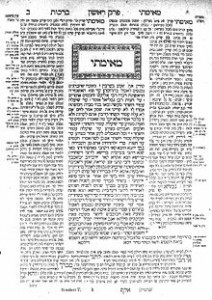I Love Learning Talmud!
Learning Talmud. It is a challenge – but it is one of the most rewarding and exciting things one can do as a Jew. To learn the whole Talmud a page a day would take one about seven and a half years to finish and you would only be touching the tip of the iceberg in everything being covered.
Some brief basics. The Talmud is the name we give to a book at whose core are two texts.
Firstly a Code of Law known as the Mishna which was redacted in about the year 200 CE by a Rabbi in Israel known as Judah the Prince. He saw dangers to the unity of the Jewish people under Roman rule and so decided that a Code of Law would be required. The laws that he would commit to writing were until then part of the Oral Torah or Torah She-Baal peh and so he was making a radical decision to write them down. So don’t be confused if someone is reading Talmud and says they are learning Oral Torah. The Talmud is a distillation and development of the Oral Torah communicated by G-d along with the Written revelation.
We call the Rabbis who lived at that time in Israel ‘Tannaim’. Rabbi Judah the Prince did not include every Rabbi’s views in this Code – he chose which one’s he felt were normative but he also left in a number of arguments and discussions between Rabbis. So the Mishna is not absolutely a rule book as such. It is definitely a guide, however there are many discussions still remaining as part of the Mishna. The Mishna was written in six orders – each order is a ‘Seder’ in Hebrew. Each Seder is based on a wide theme – such as Moed which deals with Shabbat and festivals and set times in the Jewish year. Within each Seder, there a number of Masechtot – plural for Masechet or Tractate. So in Moed (a Seder) there is a Masechet (Tractate) called Shabbat. A Tractate is split up into chapters (a chapter = perek) and each ‘Perek’ has a number of statements, each called a Mishna.
So we have Seder then Masechet then Perek then Mishna. People who learn Talmud will ask each other ‘Which Masechet are you learning?’ or ‘OK, you are learning Shabbat, which Perek are you learning?’.
Over the next 300 years in Babylon, where many thousands of Jews were already in a Diaspora created by the destruction of the first Temple in 587 BCE, schools of learning flowered in a number of towns there. Many Rabbis in Babylon, later known as ‘Amoraim’ took the Mishna of Rabbi Judah the Prince and tried to understand why he made the choices he did in writing it. Why did he choose one Rabbi’s opinion over another? Why did he write the Mishna the way he did? Why did he choose specific language usage? Do some statements he made contradict each other?
From the analysis of the Amoraim came a text known as the Gemara which was written down in about the year 500 CE although many experts are not actually sure as to exactly when it was written down other than agreeing it was around the year 500 CE.
When we learn these texts today, we learn them from a version that has at its core the text of the Mishna and the Gemara together and is called the Talmud. Most popular is a version called the Vilna Talmud which was first printed in the 1870’s in the Vilna printing house owned by the Romm family. At the centre of the page is the text of the Mishna and the Gemara. One Mishna can be a few lines, and the commentary of the Gemara relevant to that statement of Mishna can be a number of pages. A page of Talmud is called a Daf, and a Daf has two sides, each called an Amud. So a Daf has an Amud Alef (side a) and an Amud Bet (side b). So if I am presently learning on Daf Yud Chet Amud Alef, that is like saying Page 18a.
Here is a page of Vilna Talmud. This is actually the first Amud of the first Masechet of the first Seder – in other words the first page of the Talmud. It is from Tractate Brachot which you can see on the left side at the top of the page. Each Tractate begins on a Daf Bet (Page 2). Around the Talmud text are wrapped the commentaries of Rashi (on the inside of the Talmud page) and a collections of Rabbis who together are called Tosefot (on the outside of the page).
 What I will do is leave you with the information above. In my next Talmud Blog I will talk about the type of discussions that go on in the Talmud and their relevance for us today.
What I will do is leave you with the information above. In my next Talmud Blog I will talk about the type of discussions that go on in the Talmud and their relevance for us today.
